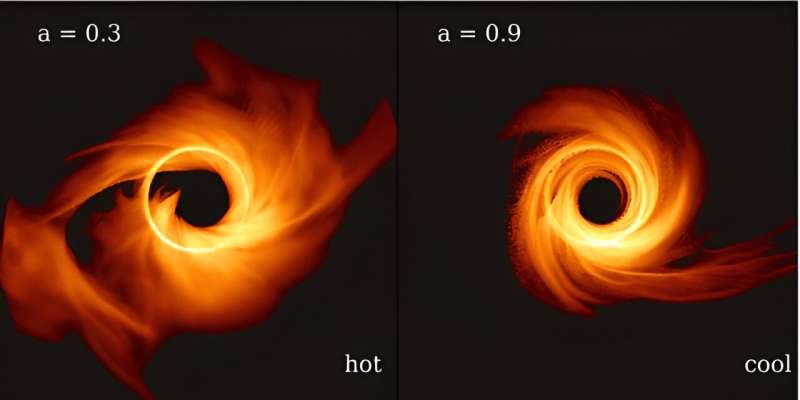This article has been reviewed according to Science X's editorial process and policies. Editors have highlighted the following attributes while ensuring the content's credibility:
fact-checked
peer-reviewed publication
trusted source
proofread
Unveiling black hole spins using polarized radio glasses

A cornerstone but surprising prediction arising from Einstein's theory of general relativity is the existence of black holes, which astronomers later found to be widespread throughout the universe. Key characteristics of black holes include their masses and their "spin"—they rotate even though they have no actual surface, with an event horizon that defines where light cannot escape.
Observers have uncovered black holes spanning a broad spread of masses, ranging from those comparable to the mass of stars to ones millions or billions of times the mass of our sun, the supermassive black holes. We now know that the majority of large galaxies harbor such supermassive black holes, although major questions remain about how they form and evolve.
While the defining characteristic of a black hole is its event horizon, we know that light does emit from regions just beyond the event horizon. Matter orbiting around the supermassive black holes does emit light, from radio to gamma rays.
Employing an array of telescopes located on Earth, the Event Horizon Telescope Collaboration (EHTC) recently obtained images of two supermassive black holes at millimeter and submillimeter wavelengths by capturing the emitted light originating from electrons orbiting within the innermost vicinity around the black hole. The main targets for the EHTC are the supermassive black hole residing at the core of the elliptical galaxy Messier 87, along with SgrA*, which lives at the very heart of our Milky Way galaxy.
The EHT images of both sources show rings of emission formed when radio waves emitted close to the event horizon are bent in the curved spacetime close to the black hole—the mass and spin of the black holes determine the size and shape of these rings.
The light emitted from the black hole's vicinity is "polarized," with a distinct orientation depending upon its origin. On Earth, we use polarized sunglasses to cut down on glare from reflected sunlight, as reflection from water or a car's windshield induces a polarization to the light.
I have recently led a team that presented an innovative approach for estimating black hole properties such as spin using the polarization—the results have just been published in The Astrophysical Journal.
We demonstrated that the spin of a black hole should detectably change the polarization of the emitted radio waves. We also found that the temperature of the rotating electrons within the plasma (gas that is so hot that all of the atoms have had their electrons stripped away) that orbits the supermassive black hole along with the strength of the magnetic field in the region all affect the results, making a complex picture but one with new power to reveal otherwise undetectable black hole characteristics.
Dr. Randall Smith, a Smithsonian Astrophysical Observatory (SAO) astrophysicist at the Center for Astrophysics | Harvard & Smithsonian (CfA), and an advisor of mine and member of the team, noted that "a supermassive black hole's spin encodes its history, giving hints as to how it has evolved over the age of the universe. However, measuring spin has proven to be extremely difficult; a new approach using radio polarization is extremely exciting, as the spins of the black holes in M87 and our Milky Way galaxy are very poorly known."
A comparison with the EHT observations obtained in 2017 indicates a preference for plasma with strong magnetic fields, plus moderate electron temperatures and a slowly rotating black hole, or alternatively, the presence of cold electrons alongside a rapidly rotating black hole. The article image illustrates a slowly spinning black hole, with a spin parameter a = 0.3 (where a = 0 corresponds to zero spin and a = 1 corresponds to the fastest possible spin) and hot electrons (on the left), in contrast to a rapidly spinning black hole, with a = 0.9 and cool electrons (on the right).
An ongoing endeavor involves a more quantitative comparison with the EHT observations. Our aim in the near future is to discern the black hole's spin by employing more advanced microphysics within our simulations that already include the effects of general relativity and strong magnetic fields.
Shep Doeleman, an SAO astrophysicist at the CfA, a Harvard University Senior Research Fellow and member of the team, notes "The next generation Event Horizon Telescope (ngEHT) is a new project to enhance the EHT by adding new dishes to the array and observing at multiple frequencies."
This strategic expansion may be able to detect the newly published effects and make unbiased estimates of black hole spin, giving us a fresh perspective on the extreme environment at the black hole boundary.
More information: Razieh Emami et al, The EB Correlation in Resolved Polarized Images: Connections to the Astrophysics of Black Holes, The Astrophysical Journal (2023). DOI: 10.3847/1538-4357/acdc96
Journal information: Astrophysical Journal
Provided by Harvard-Smithsonian Center for Astrophysics



















